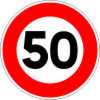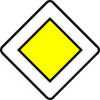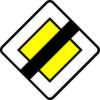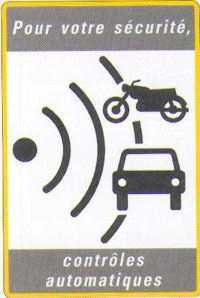Tips for Riding Abroad
REFLECTIVE HELMET STICKERS X 4

R431-1 of the code of the road states that all riders and pillions of motorcycles must wear an approved helmet and that helmet must have retro-reflective elements attached. The text does not exempt foreign riders. We can therefore deduce that British riders are subject to these regulations When they travel in France.
The standards of approval for helmets are the same in France as the UK. They are described in regulation 22-05 which leaves the choice to each State to impose the retro-reflective elements. France chose to impose these elements. Therefore a helmet without retro-reflective elements is deemed as not approved and justifies a fine of €135.
However, I would like to clarify that to this day, I have had no knowledge of a foreigner being fined on these grounds.
Catherine Galdos Coordinatrice juridique de la FFMC
HI-Viz – new requirement for 2016 in France
BIKERS in France will be required by law to carry a high visibility jacket or face a fine of up to a 135 €.
From January 1, 2016 French police can demand bikers show a yellow bib (or gilet jaune as it might be barked) with failure punishable by an 11 € fine, escalating to nearly £100 during a breakdown.
Contrary to rumours, there is no obligation in the decree to wear the vest at all times, only to carry it on the bike or person.
High visibility jackets, shirts, vests and bibs carrying a CE mark for luminosity will all be accepted but simple reflective armbands or stripes will not.
Jan 2013 – YOU WILL NOT BE FINED FOR NOT HAVING A BREATHALYSER
The need to carry a Breathalyser in France is EFFECTIVE however the fine for not carrying one is ZERO euros.
The French have started using E10 95 Sans Plumb
This is an eco fuel which has a 10% ethanol additive and is not recommended for engines/bikes older than 2000 personally I use 98 RON if I cannot find 95 RON fuel in France.
French Safety Cameras: New Legislation for 2012
Travelling in France? IMPORTANT: Please be aware of a change in French law effective from 3 January 2012 regarding the use of speed and safety camera locations.
SOME TRAVEL HINTS
1. Bike preparation. You could be riding 2,000+ miles, make sure a service is carried out prior to going. Check tyres – are they up to the mileage and at the right pressure, also settings of bike and maximum loadings, avoid overloading the bike as it will affect the handling or could cause fatigue in the frame and upset the balance/handling. Try your bike out with its loading before setting off; see if you need to ditch anything. Remember your headlamp dip direction adjusters and a GB sticker.
2. Luggage. Choose between hard and soft. Do not just bungee down a carrier bag. Remember it may rain so if you have soft luggage it will need to be waterproofed – a plastic bin bag is cheap and ideal. If you take hard luggage is it easy to remove? If not, take an insert (carrier bag?) to make it easy to unload. Don’t take too much, you will be wearing most of your kit, and you can easily wash or buy anything you need. Remember to take waterproofs. A tank bag or bum bag is very useful for cash, passport etc, and is easily removed for security, at lunch time or for sightseeing.
3. Documentation. Essential. Passport. Driving licence if the new photo type, you need to take the paper part too. Insurance, remember to inform your insurer you are going abroad. Registration document – photocopy will suffice. If you have borrowed a bike, you will need copy of the Registration document and a letter of authority from the owner. Remember in Europe new licence holders are restricted to 90 KPH for the first 2 years. Riding age is 18 yrs.
4. Recommended. European breakdown cover (AA 0800 444500 or 0870 2401456. MCN/NCI 0870 9012999 RAC 0800 550055) remember some insurance companies e.g. Carole Nash give free breakdown cover but check. EHIC reciprocal health care (available on-line). European accident statement form (from insurers, comes with green card). This is a multi language document which is ideal if you are unfortunate enough to have an accident. You might also consider travel insurance if you do ensure it covers you for riding a large capacity bike and if you are carrying a pillion make sure that is included.
5. Spares etc. Tool kit. Torch. Aerosol tyre repair kit. Spare bulbs (compulsory in most of Europe). Spare fuses, Chain lube. Bike lock. You will also need to carry a Hi-Vis vest in Europe.
6. Personal. Sunglasses or tinted visor (not illegal in Europe where they are deemed a safety item!). Sun block. Map (pocket type) even if you have SatNav. Mobile phone, ensure it has Roaming for Europe enabled, if riding in a group pass all numbers between yourselves on the ferry. Have an emergency telephone number in UK that messages can be left at for relaying/passing. Ear plugs. Tie downs/protection for tie downs. On British ferries, your bike will be secured by good tie downs, on French ferries (Sea France, eurotunnel), you may have to tie down the bike yourself, the tie downs may be dirty/oily. Protection stops damage to your bike it can be your riding gloves. Destinations address and phone number. Translator or language dictionary.
7. Riding in Europe. Auto routes in France have service areas every 20 KMS, called AIRES they have everything from rest areas and toilets to petrol stations and quality restaurants. The sign on the motorway will tell you what services are available, do not run out of fuel on the auto route, it is an automatic fine. Emergency numbers; yellow box or dial 15 Ambulance, 17 for Police, 18 for Fire. It is COMPULSORY to ride in the daytime with headlights illuminated. Europe take lunch seriously so ensure that you fill up before noon if you are off the beaten track as they are closed from 12h00 – 14h00. Most things are closed on Sundays except on major routes.
8. Advice. KPH are quickly covered. If you want to know the actual mileage, divide by 8 and multiply by 5. Distances to travel, you will average about 50 MPH if you stop for breaks, 65 MPH if you don’t. That means if you plan to travel 450-500 miles in a day you will be riding for some 10 hours, so set off accordingly. When you go to your bike, it is useful to have a KEEP RIGHT reminder on the tank or somewhere visible which you will see when inserting your keys. Also let your credit card company know you are going abroad – nothing more annoying than them cancelling your card because they think it has been stolen and being used abroad.
Further information can be found at http://english.controleradar.org/driving-in-france.php which also has highways information and speed camera locations…
| French road signs and what they mean: Some road signs are very similar to those found in the UK – but others you might not have seen – and which might have a completely different meaning than you might think – Here are some worth noting before you ride down to the Ferry… | |
 |
The same as the UK however In France ensure you put your foot down and stop. It could be an on the spot fine from a gendarme if you do not stop correctly. |
 |
National speed limits are: 50 kph (31 mph) in built-up areas, 70 kph (44 mph) in villages, 90 kph (56 mph) on the open road, 110 kph (69 mph) on dual carriageways, and 130 kph (80 mph) on motorways. |
 |
This means you are on the road with priority and you will be passing a junction |
 |
This sign means that the next road to your right has right-of-way- this sign indicates you are approaching a side road or crossroad you should give way to vehicles approaching from your right approach with caution. |
 |
This sign indicates you are entering a zone where you have priority over any vehicles approaching from junctions on the right (found on main roads and entering a town). |
 |
This sign ends that zone and you no longer have priority over vehicles joining your road from the right. |
 |
This sign indicates you are approaching a speed camera – where you see one of these there will be a speed camera. The camera will be approx 500m from where you see the sign. They look like this…
|
General Appearance
Blue signs refer to motorways; green signs to main roads; white signs to most other roads; and yellow signs to temporary deviations.
- Haute tension — High tension (electricity)
- Interdit aux pietons — Forbidden to pedestrians
- Nids de poules — Potholes (literally ‘chickens’ nests’)
- Obligatoire — Compulsory (as in ‘Deviation’)
- Peage — Toll
- Priorite pietons — Priority to pedestrians
- Route Barree — Road blocked
- Sens unique — One way
- Tout droit — Straight on
- Toutes directions — All directions
- Travaux — Road works
- Virage dangereux — Dangerous bend
- Voie etroite — Narrow lane

![speed_camera_france[2]](https://www.ridersrest.eu/riders-content/uploads/2015/11/speed_camera_france2.jpg)